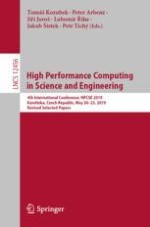2021 | Book
High Performance Computing in Science and Engineering
4th International Conference, HPCSE 2019, Karolinka, Czech Republic, May 20–23, 2019, Revised Selected Papers
Editors: Prof. Dr. Tomáš Kozubek, Prof. Dr. Peter Arbenz, Jiří Jaroš, Prof. Lubomír Říha, Dr. Jakub Šístek, Petr Tichý
Publisher: Springer International Publishing
Book Series : Lecture Notes in Computer Science
